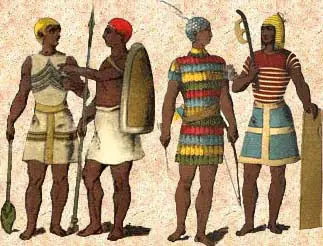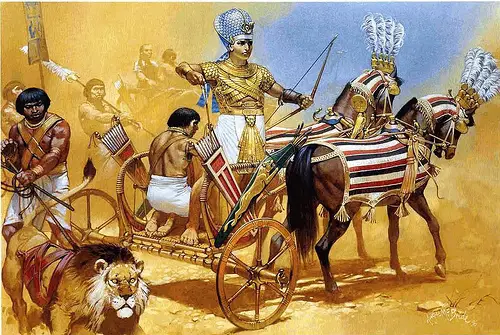Ancient Egypt was an ancient civilization of eastern North Africa, concentrated along the lower reaches of the Nile River. The civilization began around 3150 BC with the political unification of Upper and Lower Egypt under the first pharaoh and continued to thrive over the next three millennia. The history of ancient Egypt (Egyptian Armour) is divided into three stabilized kingdoms: The Old Kingdom (c.2686-2160 BC), The Middle Kingdom (c.2055-1650 BC) and The New Kingdom (c.1550-1069 BC) separated by two unstable intermediate periods.

About Egyptian Armour
During the Old and Middle Kingdoms, Egyptian armies were very basic. The Egyptian soldiers carried a simple armament consisting of a spear with a copper spearhead and a large wooden shield covered by leather hides. A stone mace carried in the archaic period was later replaced with the bronze battle Axe. The spearmen were supported by archers carrying a simple curved bow and arrows with arrowheads made of flint or copper. No armor was used during these periods.
Shields
Shields first typed the of body protection on the scene. Early Egyptian shields were tall as the man using it and restricted the warrior in his choice of weapon. The shields were made of wooden frame, often in conjunction with leather or rawhide, held by a handle or a leather strip fastened to the center of the frame. At times attempts were made to free the shield arm for offensive action, or at least for carrying another weapon.
Big shields were heavier, limiting the time they could be carried, the speed with which the soldiers could advance and their field of vision. Protection was paid for with the effectiveness of the attack. As time went on the large man sized shields slowly shrunk to a more manageable size so the Egyptian soldiers could use their spears more proficiently.

During the New Kingdom bronze was sometimes used. Metal plate shields were heavier than leather shields with wooden frames and did not necessarily afford better protection. While the bronze shield was split by the sword and pierced by the spear, the leather shield with its higher elasticity was not penetrated. The shield was carried by a strap slung over the shoulder and was thus reduced to a passive piece of Armour protecting one side of the body.
Helmets
Just as in civilian life, Egyptians at war rarely covered their heads. This is most likely due to the fact it is a desert and has a fairly hot arid climate. The pharaohs were an exception; they often wore special headgear, depicted mostly in pictures as the Pharaoh’s crown, made from linen and leather. The Asiatics which the Egyptians fought were often helmeted.
Foreign mercenaries serving in the Egyptian army continued their own traditions, which, if they were Europeans like the Sherden or Philistines, or Asiatics, generally meant wearing helmets. Nubians, on the other hand, are never shown helmeted.
Body Armour
Because of the climate, very little Egyptian Armour was ever worn in Africa. Many paintings show Egyptian infantry sporting a sword, shield, and a nice white linen loincloth. The Infantry occasionally had a triangular groin defense made from stiffened linen. The charioteers wore occasionally scale Egyptian Armour, but many preferred broad leather bands crossed over the chest or carried a shield.
Their torso was thus more or less protected, while the lower body was shielded by the chariot itself. In the 19th Dynasty, soldiers began wearing leather or cloth tunics with metal scale coverings and improved bronze casting.
The pharaohs often wore scale Armour with inlaid semi-precious stones, which offered better protection, the stones being harder than the metal used for arrow tips. Ramses II fighting as a charioteer was portrayed wearing scale Armour with sleeves, covering the whole torso. Often the use of Armour was symbolical or for ostentation. Golden corselets of mail with precious stones were made for members of the royal family and gods are at times depicted wearing Egyptian Armour.
Shelters
Soldiers attempting to destroy walls or batter gates were especially vulnerable. As early as the 20th century BCE attempts were made to protect them by shielding them with portable shelters. Egyptian siege warfare was never very effective compared to that of the Mesopotamians who developed battering rams on wheeled carriages, which protected sappers quite well.